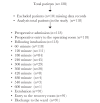Intraoperative Temperature Monitoring with Zero Heat Flux Technology (3M SpotOn Sensor) in Comparison with Tympanic and Oesophageal Temperature and Hypotermia Risk Factors: An Observational Study
- PMID: 33997837
- PMCID: PMC8098726
- DOI: 10.5152/TJAR.2020.33
Intraoperative Temperature Monitoring with Zero Heat Flux Technology (3M SpotOn Sensor) in Comparison with Tympanic and Oesophageal Temperature and Hypotermia Risk Factors: An Observational Study
Abstract
Objective: Inadvertent hypothermia (body temperature below 35°C) is a common and avoidable challenge during surgery under anaesthesia. It is related to coagulation (clotting) disorders, an increase in blood loss, and a higher rate of wound infection. One of the methods for non-invasive monitoring of the core body temperature is the 3M SpotOn zero heat flux method. In this approach, sensors placed at the frontal region of the patient measure the skin temperature by creating an isothermic channel. The study aimed to determine the risk factors for hypothermia and compare the 3M SpotOn zero heat flux method with the tympanic membrane (eardrum) and oesophageal (food pipe) temperature measurement methods.
Design: Observational.
Data sources: The patients' data were collected, including age, gender, weight, BMI, other illnesses, smoking history, type of anaesthesia, duration of surgery, operating room temperature, pulse rate, blood pressure, blood loss, and transfusions. Body temperature was measured by the tympanic membrane method before and after surgery, oesophageal method during surgery, and SpotOn measurements throughout all three periods were recorded.
Eligibility criteria: Inclusion criteria was: adult patients, both genders, who had undergone major abdominal cancer surgery at the trialists' institution, in whom the SpotOn zero heat flux, tympanic membrane, and oesophageal temperature measurement methods had all been used. Participant exclusion criteria was the absence of recorded data.
Results: In this study, inadvertent intraoperative hypothermia incidence was 38.1% in the recovery room. Although gender, presence of comorbidities, history of smoking, administration of epidural anaesthesia, and requirement of blood transfusion [red blood cells (RBCs) and fresh frozen plasma (FFP)] did not affect hypothermia significantly during admission to the recovery room, prewarming the patient throughout the operation prevented the occurrence of hypothermia significantly (p=0.004). Additionally, as the American Society of Anaesthesiologists (ASA) physical status score worsened, the rate of hypothermia increased significantly (Frequency: 1st degree, 29.4%; 2nd degree, 47.5%; 3rd degree, 66.7%; X2 Slope- p=0.047).
Conclusion: The most significant risk factor was found to be not prewarming the patient as a strict procedure, and as the ASA physical status score worsened, the rate of hypothermia increased significantly. Besides, the SpotOn method provided temperature measurements as good as the oesophageal temperature measurements. Clinical Trial registration: ISRCTN 14027708.
Keywords: Anaesthesia; hypothermia; zero heat flux sensor.
© Copyright 2021 by Turkish Anaesthesiology and Intensive Care Society.
Conflict of interest statement
Conflict of interest: The authors have no conflicts of interest to declare.
Figures
Similar articles
-
Intra-operative cutaneous temperature monitoring with zero-heat-flux technique (3M SpotOn) in comparison with oesophageal and arterial temperature: A prospective observational study.Eur J Anaesthesiol. 2018 Nov;35(11):825-830. doi: 10.1097/EJA.0000000000000822. Eur J Anaesthesiol. 2018. PMID: 29708906
-
Novel Zero-Heat-Flux Deep Body Temperature Measurement in Lower Extremity Vascular and Cardiac Surgery.J Cardiothorac Vasc Anesth. 2016 Aug;30(4):973-8. doi: 10.1053/j.jvca.2016.03.141. Epub 2016 Mar 22. J Cardiothorac Vasc Anesth. 2016. PMID: 27521967
-
Prospective comparative analysis of zero-heat-flux thermometer (SpotOn®) compared with tympanic thermometer and bladder thermometer in extremely aged patients undergoing lower extremity orthopedic surgery.Medicine (Baltimore). 2023 Oct 20;102(42):e35593. doi: 10.1097/MD.0000000000035593. Medicine (Baltimore). 2023. PMID: 37861486 Free PMC article.
-
[Intraoperative heat conservation. A lot of hot air?].Anaesthesist. 1997 Feb;46(2):81-90. doi: 10.1007/s001010050375. Anaesthesist. 1997. PMID: 9133182 Review. German.
-
Accuracy and precision of zero-heat-flux temperature measurements with the 3M™ Bair Hugger™ Temperature Monitoring System: a systematic review and meta-analysis.J Clin Monit Comput. 2021 Feb;35(1):39-49. doi: 10.1007/s10877-020-00543-6. Epub 2020 Jun 2. J Clin Monit Comput. 2021. PMID: 32488679
Cited by
-
Accuracy of a zero-heat-flux thermometer in cardiac surgery, a prospective, multicentre, method comparison study.Sci Rep. 2024 Feb 7;14(1):3169. doi: 10.1038/s41598-024-53647-3. Sci Rep. 2024. PMID: 38326589 Free PMC article.
-
Magnitude and associated factors of intra-operative hypothermia among pediatric patients undergoing elective surgery: A multi-center cross-sectional study.Ann Med Surg (Lond). 2022 Feb 8;75:103338. doi: 10.1016/j.amsu.2022.103338. eCollection 2022 Mar. Ann Med Surg (Lond). 2022. PMID: 35198184 Free PMC article.
-
Agreement of zero-heat-flux thermometry compared with infrared tympanic temperature monitoring in adults undergoing major surgery.Eur J Med Res. 2025 Jan 30;30(1):60. doi: 10.1186/s40001-025-02317-9. Eur J Med Res. 2025. PMID: 39885585 Free PMC article.
References
-
- Sessler DI. Temperature Regulation and Monitoring. Miller’s Anesth 2-Volume Set. 2015:1622–46.
-
- Benzinger THTG. Cranial measurements of internal temperature in man. In: JDH, editor. Temperature: ıts Measurement and Control in Science and Industry. New York Reinhold Publishing corporation; New York: 1963.
LinkOut - more resources
Full Text Sources
Miscellaneous

